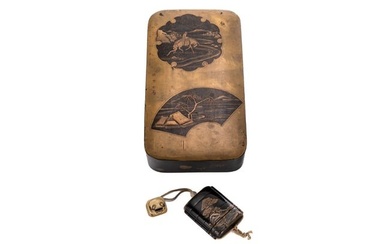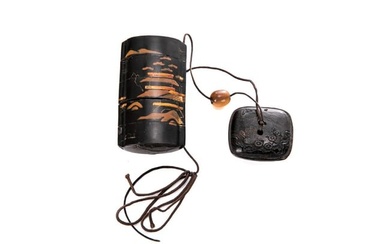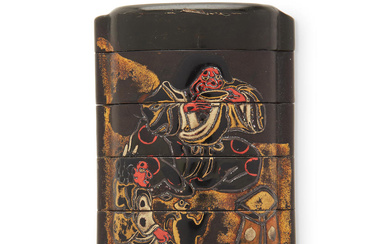Inro japanese lacquer with metal inserts - Inlaid metal, Lacquer - Samurai design - Edo period
Description: Four cases Inro in squared shape with ivory Ojime. The design carefully worked in delicate manner, finely decorated with accurate details, filling almost the whole surface, from the base and spreading over the top, depicts two famous Samurai under Matsu, pine trees, during the Juei period 1181-1183. At this time the armies of the Genji and the Heike engaged in a series of battles including Ichi no Tami, Yashima and Dan Noura. These are know collectively as the Genpei Gassen, battles of the Genji and the Heike. TECHNIQUE The very brilliant black lacquer with NASHIJI of varying density ground, framing a panel on both side containing a scroll motif of KARAKUSA in gold lacquer, decorated in TOGIDASHI with additions in KIRIGANE and inlay in high relief in metal for the both characters Rim in FUNDAME a matt gold lacquer background, the TEN top surface, and CHI bottom surface, on a matching background while the surface inside the cases has a NASHIJI background, lightly sprinkled with fine gold-dust powder to look like a starry sky. PERIOD/ORIGIN EDO period 18/19th century Japan COMMENTS The design depicted on this inro is taken from the book, EHON TSUHOSHI, published in 1729, a collection of sketches and models, illustrated by TACHIBANA MORIKUNI. Other patterns were taken from this book to decorate TSUBAS and many other INRO. In quelling the revolt of YOSHINAKA in 1184, the forces of YOSHITSUNE were required to cross the UJI river. Finding the bridge dismantled competed for the honour of being first across the river. In the lead, KAJIWARA was warned by SASAKI that his saddle girth was loose. KAJIWARA halted on the bridge. This stratagem permitted SASAKI to forge ahead and be the first to meet the enemy. During these conflicts, various legends of valour, knightly courtesy and courtly elegance were written down to become a part of the classical literature of Japan. Also, these themes became favourite subjects for fittings, painting and decorative craftswork. MATERIAL/SIZE Wood 70 x 56 x 22 mm CONDITION Basically in decent condition considering the age. Slight nicks on botton n; k surface and edge. See the detailed photos or email me for more info.
[ translate ]View it on
Sale price
Estimate
Time, Location
Auction House
Description: Four cases Inro in squared shape with ivory Ojime. The design carefully worked in delicate manner, finely decorated with accurate details, filling almost the whole surface, from the base and spreading over the top, depicts two famous Samurai under Matsu, pine trees, during the Juei period 1181-1183. At this time the armies of the Genji and the Heike engaged in a series of battles including Ichi no Tami, Yashima and Dan Noura. These are know collectively as the Genpei Gassen, battles of the Genji and the Heike. TECHNIQUE The very brilliant black lacquer with NASHIJI of varying density ground, framing a panel on both side containing a scroll motif of KARAKUSA in gold lacquer, decorated in TOGIDASHI with additions in KIRIGANE and inlay in high relief in metal for the both characters Rim in FUNDAME a matt gold lacquer background, the TEN top surface, and CHI bottom surface, on a matching background while the surface inside the cases has a NASHIJI background, lightly sprinkled with fine gold-dust powder to look like a starry sky. PERIOD/ORIGIN EDO period 18/19th century Japan COMMENTS The design depicted on this inro is taken from the book, EHON TSUHOSHI, published in 1729, a collection of sketches and models, illustrated by TACHIBANA MORIKUNI. Other patterns were taken from this book to decorate TSUBAS and many other INRO. In quelling the revolt of YOSHINAKA in 1184, the forces of YOSHITSUNE were required to cross the UJI river. Finding the bridge dismantled competed for the honour of being first across the river. In the lead, KAJIWARA was warned by SASAKI that his saddle girth was loose. KAJIWARA halted on the bridge. This stratagem permitted SASAKI to forge ahead and be the first to meet the enemy. During these conflicts, various legends of valour, knightly courtesy and courtly elegance were written down to become a part of the classical literature of Japan. Also, these themes became favourite subjects for fittings, painting and decorative craftswork. MATERIAL/SIZE Wood 70 x 56 x 22 mm CONDITION Basically in decent condition considering the age. Slight nicks on botton n; k surface and edge. See the detailed photos or email me for more info.
[ translate ]






